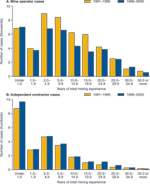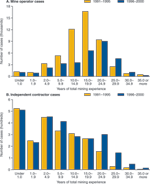Click on Image for Larger View.
| 1 |  | Figure 3-34 Distribution of farm workers by years in U.S. farm work, 1999. In 1999, 36% percent of farm workers had been employed more than 10 years in farm work. (Sources: DOL [2001]; Steege and Baron [2002].)
|
| |
| 2 |  | Figure 3-39 Percentage of farm workers reporting at least one health condition during the preceding 12 months by years in U.S. farm work, 1999. In 1999, the percentage of farm workers reporting at least one health condition (respiratory, musculoskeletal, dermatologic, or gastrointestinal) during the preceding 12 months increased gradually with years of farm work. The lowest percentage (19%) was reported for farm workers with less than 1 year of work experience in U.S. farming. The highest percentage (34%) was reported for farm workers with more than 10 years of U.S. farm work. (Sources: DOL [2001]; Steege and Baron [2002].)
|
| |
| 3 |  | Figure 3-40 Percentage of farm workers reporting joint or muscle pain in at least one body part during the preceding 12 months by years in U.S. farm work, 1999. In 1999, the percentage of workers reporting joint or muscle pain in the back, shoulder, elbow/arm, hand/wrist, or legs/feet ranged from 11% for those in their first year of U.S. farm work to 19% for workers with more than 10 years of this work. (Sources: DOL [2001]; Steege and Baron [2002].)
|
| |
| 4 |  | Figure 3-42 Percentage of farm workers reporting dermatitis during the preceding 12 months by years in U.S. farm work, 1999. The percentage of farm workers reporting dermatitis on the hands, arms, face, torso, or legs in 1999 was similar regardless of the number of years in U.S. farm work. The percentage ranged from 6.7% in farm workers with less than 5 years of U.S. farm work to 7.8% in those with 5-10 years of this work. (Sources: DOL [2001]; Steege and Baron [2002].)
|
| |
| 5 |  | Figure 3-44 Percentage of farm workers reporting wheezing or whistling in the chest at any time during the preceding 12 months by years in U.S. farm work, 1999. The percentage of farm workers reporting wheezing or whistling in the chest increased with years of U.S. farm work, from 1.5% of farm workers with less than 1 year to 4.7% of those with more than 10 years of this work. (Sources: DOL [2001]; Steege and Baron [2002].)
|
| |
| 6 |  | Figure 4-6 Rates of fatal mining injuries by type of employer and commodity, 1993-1997 and 1998-2002. For these two periods, the 5-year average rate of fatal mining injuries declined from 30.2 per 100,000 full-time equivalent workers (1993-1997) to 27.7 (1998-2002). Most of this decline was due to decreases in the rates of fatal mining injuries among independent contractor workers, stone operator workers, and nonmetal operator workers. Increased rates occurred among sand and gravel operator workers and metal operator workers. (Sources: MSHA [2003]; NIOSH [2003a].)
|
| |
| 7 |  | Figure 4-15 Distribution of lost-workday injuries among miners by type of employer and commodity and years of total mining experience, 2002. In 2002, the proportion of workers with lost-workday injuries was highest among coal operator workers with more than 5 years of experience, and lowest among coal operator workers with less than 1 year of experience. Of the mine workers with less than 1 year of mining experience, independent contractor workers had the highest proportions of lost-workday injuries. These differences must be interpreted with caution, since years of mining experience were not reported for 10% of cases. (Sources: MSHA [2003]; NIOSH [2003a].)
|
| |
| 8 |  | Figure 4-16 Number of nonfatal injury and illness cases in metal/nonmetal mines by years of total mining experience for 1991-1995 and 1996-2000: (A) mine operator cases, and (B) independent contractor cases. During 1991-2000, the role of total mining experience was fairly consistent and stable over time among mine operator worker cases of nonfatal injury or illness in metal/nonmetal mines. The number of cases was characteristically reduced during the second year of experience and followed by an upsurge for the next 3 to 4 years. A steady decline thereafter suggests that experience continually reduces risk for miners. The later period (1996-2000) showed some improvement over the early period (1991-1995). Metal/nonmetal-independent contractor cases showed a similar pattern, but with higher case counts for the least experienced miners. (Sources: MSHA [2002]; NIOSH [2003b].)
|
| |
| 9 |  | Figure 4-17 Number of injury and illness cases in coal mines by years of total mining experience for 1991-1995 and 1996-2000: (A) mine operator cases, and (B) independent contractor cases. Coal mining showed a distinctly different pattern from metal/nonmetal mining for 1991-2000. Mine operators reported increasing numbers of cases with increasing years of mining experience up until 20-24.9 years. As with metal/nonmetal mining, a dramatic drop in overall case count occurred for coal miners between the early and late 1990s. The shift in the experience group with the highest case count may reflect the aging of the mining workforce. The role of experience among independent contractor workers was similar but more pronounced for new miners. Note that case counts alone may be misleading. Incidence rates (cases per 100 full-time equivalent workers) may show different patterns, but they could not be developed because employment by years of experience was not available. (Sources: MSHA [2002]; NIOSH [2003b].)
|
| |

